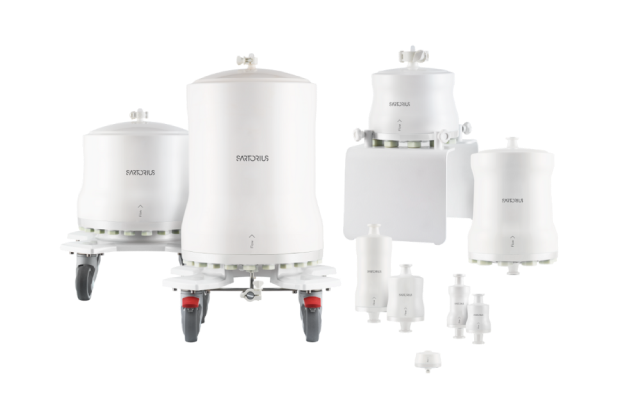Sartorius BIA Separations
CIMmultus® Oligo dT18 (C6 Linker) column is designed for the effective isolation of messenger RNA while eliminating other elements from the in-vitro transcription (IVT) mixture. This column employs affinity-based chromatography for purification of polyA RNA (mRNA) from crude samples, such as IVT mix, and can purify RNA molecules exceeding 10 kb in length, such as saRNA.
- Convective flow enables rapid purification with low shear and backpressure, preserving mRNA integrity
- Reusability across multiple cycles reduces cost and supports high-throughput needs
- Direct loading of IVT material without buffer exchange simplifies downstream workflows
- cGMP-compliant, suitable for clinical and commercial production
- Supports full process development: from high-throughput screening (CIM® Monolithic Well Plates, CIM® Octa) to prep-scale columns (1 mL–8 L) and beyond (up to 40 L on request)
Products
Filter Products
CIMmultus® Oligo dT18 (C6): High-Capacity Monolithic Chromatography Columns for mRNA Purification
CIMmultus® Oligo dT18 utilizes a covalently bound 18-mer deoxythymidine (dT18) ligand, enabling the binding of RNA with a poly(A) tail through hybridization between adenine bases on the RNA and deoxythymine (dT) bases on the ligand. The C6 linker is the arm between the monolith matrix and the dT18 ligand. It ensures robust ligand attachment, maintaining column stability across a wide range of operating conditions.
This column is highly effective for capturing mRNA. The purification process involves applying the sample at elevated ionic strength, followed by recovery of RNA through reducing ionic strength to dissociate hydrogen bonds. CIMmultus® Oligo dT18 is reusable, with stability demonstrated for at least 40 cleaning cycles. Its performance can be optimized by adjusting chromatographic conditions such as pH, flow rate, and salt concentration.
Oligo dT18 is available with 6-Carbon and 12-Carbon linker. Performance is comparable, but can be further evaluated if desired. The starting column of choice is with 12-Carbon linker.
Chromatography Mode: affinity with Oligo dT18 ligand
Ligand Density: 0.5 – 1 mg dT18/mL wet support ensuring high binding capacity
Dynamic Binding Capacity: Up to 2 – 4 mg mRNA/mL of monolith using IVT-derived mRNA.
Recovery Rate: The recovery of mRNA from the column is typically 90% and higher.
pH ranges: Operation: pH 2–10 | Cleaning in place (CIP): pH 1–13
Operating Flow Rate and Maximum Pressure: Refer to Instructions for Use (IFU) for your column volume
Chemical Compatibility: Compatible with all commonly used aqueous buffers, sodium hydroxide (short term up to 0.5 M), 6 M guanidine hydrochloride, 12 M guanidine thiocyanate, 10 M urea and 20% ethanol.
Cleaning and Sanitization: CIP: 0.5 M NaOH
Neutralization | Equilibration: Concentrated buffer (e.g. Tris, pH 7) with high salt or 1 M ammonium acetate
Storage: 20% ethanol
Shelf Life: 3 years
Library
FAQ About CIMmultus® Oligo dT18 (C6)
CIM® Oligo dT18 column’s monolithic design allows for faster flow rates at lower backpressures, significantly reducing purification times and enhancing throughput compared to conventional packed-bed columns. Another important advantage is simple scalability. Monoliths can be easily scaled up or down without losing performance, making them versatile for various applications from research to industrial production.
Yes, these columns are designed for multiple uses, depending on the specific application, sample purity, and cleaning protocols. Testing showed stability of columns up to at least 40 cycles of cleaning in place (CIP) performed, 30 minutes each. Typical lifetime exceeds this value.
CIMmultus® Oligo dT is a hybridization-affinity chromatography monolith which binds RNA with a poly-A tail, while species lacking a poly-A sequence, including dsRNA, flow through the column. If dsRNA impurities removal is the primary objective, it is recommended to use ion pair reversed phase with CIMmultus® SDVB which can efficiently remove dsRNA in an acetonitrile gradient at room temperature.
The Oligo dT column with C6 and C12 linkers share the same chemistry, the only difference is the length of the linker arm between the monolith matrix and the dT18 ligand. Both the C6 and C12 linkers are available due to historical reasons (some customers use C6 linker in clinical manufacturing), but we ordinarily suggest the longer C12 linker. We have not identified differences in performance between C6 and C12 in terms of capacity, recovery, and physicochemical characterization of the product or correlation with RNA length or other parameter.

